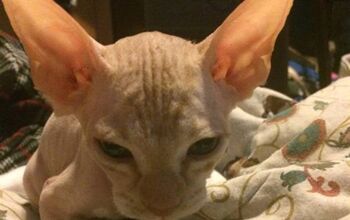4 Hairless Cat Breeds

Although you might be familiar with the Sphynx cat, there are other hairless breeds that are just as intriguing and worth checking out if you want to add a rare hairless kitty to your household. Here are four hairless cat breeds and some of their distinctive features.
Sphynx
The most well-known hairless cat breed is the Sphynx. It’s the result of a spontaneous mutation, and dates back to 1966 when a hairless kitten was born in Toronto, Canada to a domestic cat. It took many years to develop the Sphynx, which is a beloved breed today.
These unique looking cats have big ears and large eyes, along with wrinkly skin. But more important than their appearance is the fact that they have a wonderful personality, making them fantastic pets. This kitty can be your perfect companion if you’re looking for a feline who will want to be near you as much as possible. They feel like warm suede, and they’re smart, outgoing, and talkative.
Donskoy
Also known as the Don Sphynx, the Donskoy is a cat breed from Rostov-on-Don, Russia that started because of a spontaneous mutation in 1987. These cats have four coat types, and because this breed carries a hair loss gene, they may lose hair that they’re born with. Also, these kitties may even grow some hair on the chest and tail in the winter and lose it when the season ends.
- If a kitten is born bald and stays that way, they have the rubber bald coat.
- If they have the velour coat, they are born with a bald spot on their head and a wavy coat, but as they grow, they’ll only have hair on the tail, face, and legs and they may become bald.
- With the brush coat, a cat has bald spots, but they’ll have more hair than Donskoys with other coat types.
- The flocked coat will give a cat the appearance of being hairless but will feel like soft chamois, and that hair could fall out, leaving the cat bald.
Regardless of coat type, these kitties are sociable, smart, active, and friendly. They like to play and be around people, and they don’t like being left alone for too long.
Peterbald
The Peterbald is a newer cat breed from Russia that dates back to 1994 when a Donskoy was bred with an Oriental Shorthair. These eye-catching cats can have different coat textures (naked, flock, chamois, straight, brush), and they can be hairless or fully coated. According to the breed standard, the coat can even change multiple times over a Peterbald’s life.
These cats are smart, social, playful, and active. They prefer getting a lot of attention from their family, so they like spending time with you and will be affectionate, vocal, and loyal.
Bambino
The Bambino is a dwarf cat breed that weighs an average of 5 to 9 pounds and is an average of 7 to 8 inches tall. This breed carries the hairless gene and the short-legged gene because it was developed by crossing the Sphynx and Munchkin.
Bambinos maintain a kitten-like appearance, with wrinkly skin and big eyes and ears, even when fully grown because of their tiny size. They’re active and fun, and enjoy playing with toys. They’re also affectionate and thrive when they’re part of a family that interacts with them and gives them the attention they crave.
Tips for Caring for a Hairless Cat
Hairless cats are just like other cats when it comes to their basic needs and personalities. They make awesome pets and loving companions, and many people adore them for their standout looks that distinguish them from other breeds. But because they don’t have fur, pet parents need to provide these kitties with some extra care.
Before deciding that you want to bring a hairless cat home, keep the following in mind:
- They can get a sunburn, so taking steps to protect their delicate skin from the sun’s UV rays is important, especially in the summer when the sun is harshest. You can do so with UV blocking film that’s easily applied to your windows, and by keeping your cat indoors.
- They need to be bathed regularly with a gentle shampoo that will keep their skin healthy and remove excess oil, and they need to have their ears cleaned. When their skin is too oily, it can even leave stains on your furniture. You can bathe your cat yourself or go to a professional cat groomer.
- They can get cold easily, so purchasing products like heated beds and blankets is wise. If your kitty doesn’t mind wearing clothes, you can find sweaters, hoodies, and shirts for hairless cats—these can also work to protect their skin. An example is the Kitipcoo Limited Edition Sphynx Cat Cotton T-Shirt, which is available in various styles and sizes and is made of soft material.
Carefully Consider Which Hairless Cat Breed Is Right for You
Before bringing a purebred cat home, do some research to be sure you select the right breed for your family and lifestyle. After all, different cat breeds have varying requirements and temperaments that should be considered, in addition to the specific needs of hairless kitties. Once you’ve found your match, you can then find reputable and trustworthy breeders, or you can search for purebred hairless cats in rescues and shelters so you can adopt one instead.
Join the PetGuide community. Get the latest pet news and product recommendations by subscribing to our newsletter here.

Lisa Selvaggio is a freelance writer and editor, and our resident cats-pert, with certifications in pet nutrition and pet first aid. She enjoys producing content that helps people understand animals better so they can give their pets a safe and happy home.
More by Lisa Selvaggio























